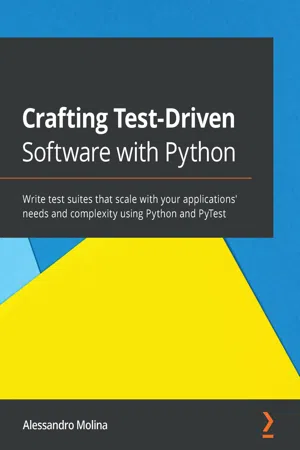
Crafting Test-Driven Software with Python
Write test suites that scale with your applications' needs and complexity using Python and PyTest
- 338 pages
- English
- ePUB (mobile friendly)
- Available on iOS & Android
Crafting Test-Driven Software with Python
Write test suites that scale with your applications' needs and complexity using Python and PyTest
About this book
Get to grips with essential concepts and step-by-step explanations to apply TDD practices to your Python projects while keeping your test suite under control
Key Features
- Build robust Python applications using TDD and BDD methodologies
- Test Python web applications using WebTest and web frameworks
- Leverage PyTest to implement stringent testing mechanisms to ensure fault-tolerant applications
Book Description
Test-driven development (TDD) is a set of best practices that helps developers to build more scalable software and is used to increase the robustness of software by using automatic tests. This book shows you how to apply TDD practices effectively in Python projects.
You'll begin by learning about built-in unit tests and Mocks before covering rich frameworks like PyTest and web-based libraries such as WebTest and Robot Framework, discovering how Python allows you to embrace all modern testing practices with ease. Moving on, you'll find out how to design tests and balance them with new feature development and learn how to create a complete test suite with PyTest. The book helps you adopt a hands-on approach to implementing TDD and associated methodologies that will have you up and running and make you more productive in no time. With the help of step-by-step explanations of essential concepts and practical examples, you'll explore automatic tests and TDD best practices and get to grips with the methodologies and tools available in Python for creating effective and robust applications.
By the end of this Python book, you will be able to write reliable test suites in Python to ensure the long-term resilience of your application using the range of libraries offered by Python for testing and development.
What you will learn
- Find out how tests can make your life easier as a developer and discover related best practices
- Explore PyTest, the most widespread testing framework for Python
- Get to grips with the most common PyTest plugins, including coverage, flaky, xdist, and picked
- Write functional tests for WSGI web applications with WebTest
- Run end-to-end tests for web applications using Robot Framework
- Understand what test-driven development means and why it is important
- Discover how to use the range of tools available in Python
- Build reliable and robust applications
Who this book is for
This book is for Python developers looking to get started with test-driven development and developers who want to learn about the testing tools available in Python. Developers who want to create web applications with Python and plan to implement TDD methodology with PyTest will find this book useful. Basic knowledge of Python programming is required.
Frequently asked questions
- Essential is ideal for learners and professionals who enjoy exploring a wide range of subjects. Access the Essential Library with 800,000+ trusted titles and best-sellers across business, personal growth, and the humanities. Includes unlimited reading time and Standard Read Aloud voice.
- Complete: Perfect for advanced learners and researchers needing full, unrestricted access. Unlock 1.4M+ books across hundreds of subjects, including academic and specialized titles. The Complete Plan also includes advanced features like Premium Read Aloud and Research Assistant.
Please note we cannot support devices running on iOS 13 and Android 7 or earlier. Learn more about using the app.
Information
- Chapter 1, Getting Started with Software Testing
- Chapter 2, Test Doubles with a Chat Application
- Chapter 3, Test-Driven Development while Creating a TODO List
- Chapter 4, Scaling the Test Suite
- Introducing software testing and quality control
- Introducing automatic tests and test suites
- Introducing test-driven development and unit tests
- Understanding integration and functional tests
- Understanding the testing pyramid and trophy
Technical requirements
Introducing software testing and quality control
Test plans
- Preconditions: What's necessary to be able to verify the case
- Steps: Actions that have to succeed when executed in the specified order
- Postconditions: In which state the system is expected to be at the end of the steps
| Test Case: 2.2 - Change User Password | ||||||||||||||||||||
| Preconditions:
| ||||||||||||||||||||
| ||||||||||||||||||||
| Postconditions:
|
Introducing automatic tests and test suites
import unittest
class MyTestCase(unittest.TestCase):
def test_one(self):
pass
$ python 01_automatictests.py
$
Table of contents
- Title Page
- Copyright and Credits
- Dedication
- Contributors
- Preface
- Section 1: Software Testing and Test-Driven Development
- Getting Started with Software Testing
- Test Doubles with a Chat Application
- Test-Driven Development while Creating a TODO List
- Scaling the Test Suite
- Section 2: PyTest for Python Testing
- Introduction to PyTest
- Dynamic and Parametric Tests and Fixtures
- Fitness Function with a Contact Book Application
- PyTest Essential Plugins
- Managing Test Environments with Tox
- Testing Documentation and Property-Based Testing
- Section 3: Testing for the Web
- Testing for the Web: WSGI versus HTTP
- End-to-End Testing with the Robot Framework
- About Packt
- Other Books You May Enjoy